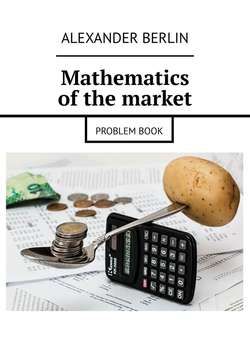Читать книгу Mathematics of the market. Problem book - Alexander Berlin - Страница 5
Chapter 2. The market as a system with obvious losses. Basic concepts
Оглавление2.1. A mathematical model of the market as a system with obvious losses
In this Chapter we consider methods for calculating throughput of market with full accessibility in the system with obvious losses.
We will consider a simplified mathematical model shown in Fig.2.1.
Fig.2.1. Model of the market as a system with obvious losses
In this model, is considered
– the incoming flow of goods, from the system of production
– the flow then enters the distribution system.
– which delivers it into the system of consumption.
The main assumptions which allow to mathematically investigating this process.
Incoming flow:
– consists of identical goods, (this property is named ordinariness)
– result processing of the goods in this moment time does not depend on the results of previous processing (this property is named stationary);
– follow processing of goods the does not depend on the results of previous processing (this property is named the lack of aftereffect).
Random flow, which has all three properties, is called the simplest and well-studied in mass service theory [2.1, 2.2, and 4.3].
The market distribution system
It is assumed that this system has no any stimulating or limiting effect on the service process goods
The system of consumption operates as follows.
The system consists of n groups (or individual) consumers.
Each group receiving a certain amount of goods and after out some time (time of consumption – tconsum) and may be free for further consumption.
For example, a consumer who bought a vehicle, uses it (consumes) for about 3 years, and then begins to look for a new one.
Not to be confused with the time of consumption and time of possession. User has
the old car, but as soon as he begins to look for a new one car – this point is the end point of consumption.
If satisfied demands one of a group of consumption then the number of groups decreases by one, i.e., for consumption remains n-1 group.
At high intensity can be that there will come a time when all n groups of customers will busy.
Whereupon, the received goods will not be sold. Unsold merchandise we will call a LOSSES.
The probability of losses of the goods with a certain number of receipts and number of groups consumption, can give answer one or more questions.
For example,
1. At what size supply, losses will exceed a given norm?
2. What number of goods can processing the market in a given time?
3. How much should be consumer groups to ensure that given quantities of goods were sold with losses less than or equal to the specified norm?
4. What happens to losses if we increase the supply at a certain value? The appearance on the market of new suppliers or an increase in the supply of production.
The answers to these questions can be found by applying the formula of Erlang.
2.2. The first Erlang formula for the calculation of market indicators
The first Erlang formula has the form.
The first Erlang formula
where A is the value proposal, expressed in relative units (see further explanations)
E1,n (A) – value of loss for the consumer system of n groups (the number one indicates that this is the first Erlang formula, then will the area of application of the second formula Erlang).
